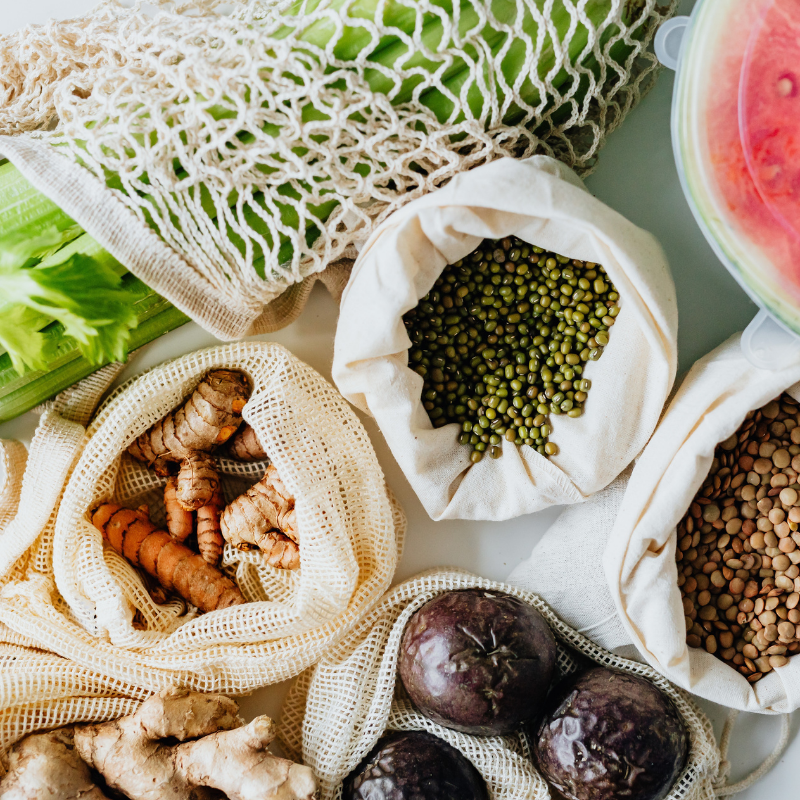
I know fiber is good for me, but what is it again?
We have all heard fiber is good for us, but what is fiber again, what foods is it in, and why is it good for me? Fiber is a carbohydrate that the body cannot fully digest and is found in plant-based foods like fruits, veggies, whole grains, beans, etc. Fiber has numerous health benefits, including improved digestion, blood-sugar balance, increased satiety, and more! In this post, we are diving deep into all things fiber!
Insoluble vs. Soluble Fiber
It turns out all fiber is not the same. There are two different types of fiber: soluble and insoluble. Both types of fiber possess their unique characteristics and therefore play different roles in the body.
As soluble fiber digests, it dissolves in water and other body fluids, forming a gel-like substance (Have you ever noticed when chia seeds expand in water or chia seed pudding – it’s the same thing!). As a result, soluble fiber slows down digestion and nutrient absorption in the stomach and small intestine. This is why soluble fiber helps to balance blood sugar, where it slows digestion and, therefore, the release of carbohydrates (glucose) into the bloodstream. Couple that with an increased volume of food in the stomach (due to the absorption of liquid by the fiber), and the body receives a signal of satiety. If that is not enough, soluble fiber acts as a prebiotic where the beneficial bacteria in the colon feeds on this fiber, helping to nourish the gut microbiome.
Note that this is often the reason for discomfort when eating a fiber-heavy meal because the fermentation of fiber byproducts by the gut bacteria produces gas in the large intestine. Some gas and minimal discomfort is totally normal (and a good sign your GI tract is functioning as it should); however, too much pain or a very unpleasant odor is a sign to cut down on the fiber intake a bit and take a deeper look at the gut microbiome.
In contrast, insoluble fiber acts differently than soluble fiber as it cannot be digested by bacteria and does not dissolve in fluids. Rather, as insoluble fiber moves through the GI tract, it absorbs liquids and sticks to byproducts of digestion to form stool. This results in softer, easier to pass stool.
Summary of fiber’s health benefits:
- Helps promote satiety and reduce cravings
- Improves blood-sugar balance
- Weight management
- Aids in detoxification (may help balance cholesterol and other hormones)
- Helps to regulate bowel movements
- Aids in a healthy gut microbiome
- Decreases risk of colorectal cancer
Everyone needs and can benefit from fiber. However, if you have GI issues (think: IBD, IBS, Crohn’s disease, ulcerative colitis, diverticulitis) then your body may actually do better with less fiber than more. This is not to say you should not eat fiber – remember it is very much your friend! Our suggestion is progressing slowly, drinking tons of water, eating cooked veggies rather than raw (this is a lot more gentle on your digestion!), and finding the right balance of soluble and insoluble fiber for you!.
Foods with Fiber
As mentioned above, fiber is the plant “roughage” and is found in plant-based foods like fruits, veggies, whole grains, beans, etc. However, not all plant-based foods are created equal, with some having more fiber than others.
Foods high in soluble fiber:
- Oatmeal
- Cruciferous Veggies: Brussels, broccoli
- Root Veggies: carrots, turnips, sweet potatoes
- Beans, lentils, legumes
- Fruits: apples, pears, figs, berries
- Nuts and Seeds: Flaxseeds, hazelnuts, sunflower seeds, chia seeds
- Psyllium Husk
Foods high in insoluble fiber:
- Fruit: Avocado, Berries, kiwi, mango, apple
- Green Beans
- Beans, lentils, legumes
- Wheat bran or oat bran
- Dark Leafy greens: spinach, kale, arugula
- Complex Carbs: Brown rice, potatoes, quinoa, turnips, carrots
- Cruciferous Veggies: cauliflower, Brussels sprouts
- Nuts and Seeds: Almonds, walnuts, sesame seeds, chia seeds
As you read through the above, you may have noticed that many of these foods contain both types of fiber, and this is not a bad thing – it helps keep a good ratio of both!
5 tips to increase fiber intake
- Incorporate at least one fruit or veggie with every meal (make sure to eat them with the skin!)
- Increase fiber slowly! Start by adding in one more serving of fruits/veggies (or about 5g) for a few days, then see how you feel and increase it!
- Utilize seeds like chia and flax seeds that can easily be added into smoothies, sprinkled on top of salads, and incorporated into snacks (chia seed pudding, flackers, etc.) that will quickly boost fiber intake
- Make a soup with tons of veggies, beans/legumes, and whole grain of choice for an easy and delicious way to increase fiber (don’t forget that often cooked veggies are easier to digest)!
- Do not forget to hydrate! Seriously, if you are not upping your water intake while increasing fiber, this will back you up!
Bottom Line
Fiber is your friend! Soluble fiber increases satiety, stabilizes blood sugar, feeds the gut microbiome, and more, while insoluble fiber helps move food waste through the GI tract promoting regularity and aiding in detoxification. Foods containing fiber include fruits, veggies, whole grains, complex carbs, nuts, and seeds.
Want to include more fiber in your diet? Or, maybe your gut is not responding to fiber great, and you need some guidance. Then, click here to work with us!
Written by Alison Richman MS, RDN







